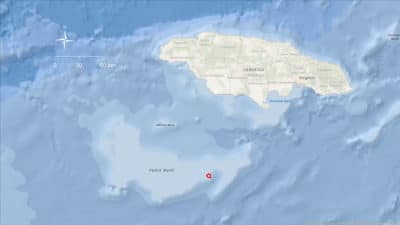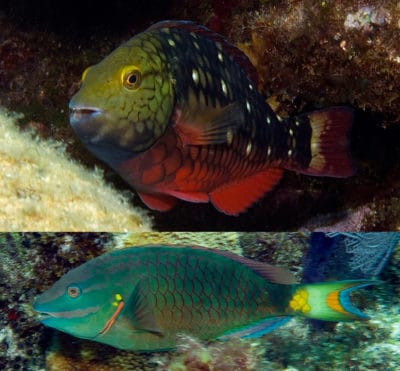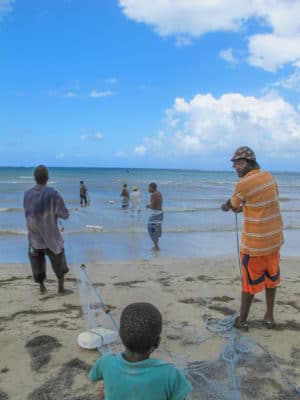Fearless Sharks and Gender Changing Fish
When we set out to survey the reefs on Pedro Bank, Jamaica, we didn’t know that we were going to find two fish mysteries to solve: one about small stoplight parrotfishes and the other about much larger nurse sharks … both ultimately linked to overfishing.
Altered Fish Behavior Linked to Overfishing?

Pedro bank lies approximately 70 kilometers south of Jamaica; it is an underwater bank that covers roughly 8,000 square kilometers. It breaks the surface in a few places creating small islands known as cays. And, in March of 2012 our 17-member scientific team, including both Jamaican and American scientists, was tasked with surveying an area close to one of these cays to see if it could be a viable fish sanctuary. During our survey, we noticed some interesting fish behavior.
Fish Counting Anyone?
 Part of the research involves counting fish. Dave Grenda, Ken Marks, Oliver Squire, and Anna Ebanks were the fish counters this time. Each scientist holds a large black and white striped T-shaped bar as they swim and they take note of the species, size, and number of fish they see in front of the bar. They began to notice something strange, many small, terminal phase, male parrotfish.
Part of the research involves counting fish. Dave Grenda, Ken Marks, Oliver Squire, and Anna Ebanks were the fish counters this time. Each scientist holds a large black and white striped T-shaped bar as they swim and they take note of the species, size, and number of fish they see in front of the bar. They began to notice something strange, many small, terminal phase, male parrotfish.
For the most part young stoplight parrot fish are female. As they get larger they change gender and become male, a not uncommon occurrence in the world of fishes. They change color, become known as ‘terminal phase’ males, and are dominant fish that can control and mate with many female fish. Large male fish are much more successful, reproductively speaking, than small males. So a large fish has mated as a female when he is small, then turned into a dominant male and continues to reproduce. Scientists have long known roughly what size parrotfish switch from being female to male, a process that depends on genetics, environmental, and social conditions. But our team found that on Pedro bank the fish were making the switch at a much smaller size than expected. What was the cause of this altered fish behavior?
They change color, become known as ‘terminal phase’ males, and are dominant fish that can control and mate with many female fish. Large male fish are much more successful, reproductively speaking, than small males. So a large fish has mated as a female when he is small, then turned into a dominant male and continues to reproduce. Scientists have long known roughly what size parrotfish switch from being female to male, a process that depends on genetics, environmental, and social conditions. But our team found that on Pedro bank the fish were making the switch at a much smaller size than expected. What was the cause of this altered fish behavior?
Sharks!
Swimming near the fish-counting divers other scientists take note about what’s on the seabed: it can be coral, sponges, rubble, sand, or seagrass among other things, this is called a benthic survey. These researchers noticed a lot of nurse sharks on every dive and also saw many lion fish, a pest species that is not native to Jamaica. Removing the lionfish is good for the native fish.
Team member Rachel D’Silva, found and collected a lionfish. She stuffed it into her collection bag  along with her other equipment and put her bag down to continue her survey. She had only gone a few feet when a nurse shark zipped down to steal her collection bag, lionfish, scissors and all. Sharks usually stay well away from humans, so this was another highly unusual fish behavior on Pedro Bank.
along with her other equipment and put her bag down to continue her survey. She had only gone a few feet when a nurse shark zipped down to steal her collection bag, lionfish, scissors and all. Sharks usually stay well away from humans, so this was another highly unusual fish behavior on Pedro Bank.
Making sense of the altered fish behavior, and all the other data, is the job of chief scientist Dr. Andrew Bruckner. He crunched the numbers over several months and the scientific analysis confirms what had seemed evident on Pedro bank. That overfishing is taking a toll on the entire ecosystem and changing it in ways that nobody had expected.
Overfishing on Pedro Bank
Fishermen live on two of the cays where the team was surveying. Small huts ring the shorelines of the cays and the men spend long, hard, days at sea catching whatever they can.
 Our data showed a significant drop in the population of all commercial fish species. Particularly in areas close to the fishing villages. When we compared survey sites close to the villages to those far away we saw that about 20 miles out from shore the number of fish starts to increase. This is roughly the maximum distance the fishermen will travel to fish in their small open topped boats.
Our data showed a significant drop in the population of all commercial fish species. Particularly in areas close to the fishing villages. When we compared survey sites close to the villages to those far away we saw that about 20 miles out from shore the number of fish starts to increase. This is roughly the maximum distance the fishermen will travel to fish in their small open topped boats.
Our results showed that parrotfish were fairly plentiful, but they were all extremely small. The larger parrotfish have all been caught. So this explains mystery number 1 – why we saw many small male stoplight fish. Since the fishing pressure isn’t allowing fish to grow above a certain size, the fish have to change gender at a smaller size or the females won’t find a mate. We believe that the smaller than average size in sex change is a survival adaptation by the fish, caused by overfishing. This has been seen in other areas with a high fishing pressure but is quite alarming because small fish produce smaller, weaker offspring, and make it hard for the fish population to increase.
Similarly we think the altered fish behavior of the sharks is a response to heavy fishing in the area but in a different sort of way. The fishermen know that the lionfish are bad for the native fish, and they regularly kill this invasive species underwater with their spear guns leaving the carcasses on the reef. The sharks have come to associate people underwater with an easy meal of lionfish. So the nurse sharks have lost some of their natural fear of people and are now coming close … again due to overfishing.
MARINE PROTECTED AREA
The good news is that our numbers showed plenty of fish eggs and larvae within the proposed no take zone, so if the overfishing eased up the area would likely recover. And, even better, in March 2012 the Jamaican government created the first ever Marine Protected Area on Pedro Bank. When fish stocks begin to recover it will be good news for the fish, coral, and fishermen.
